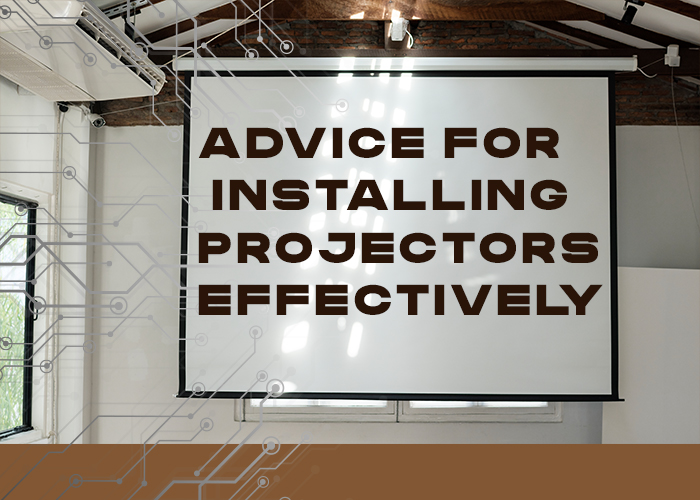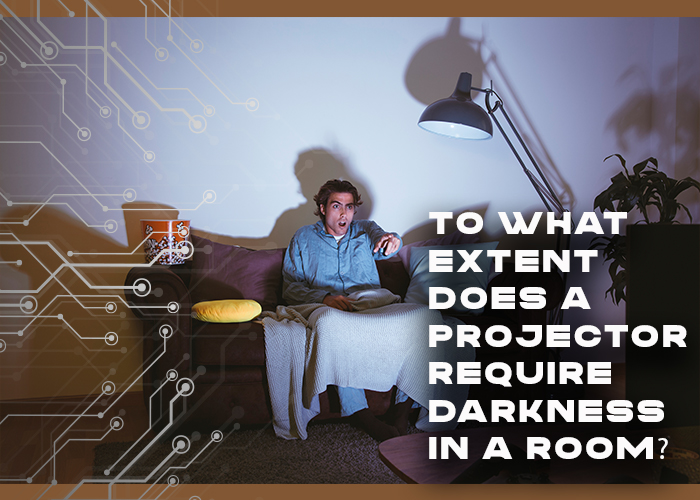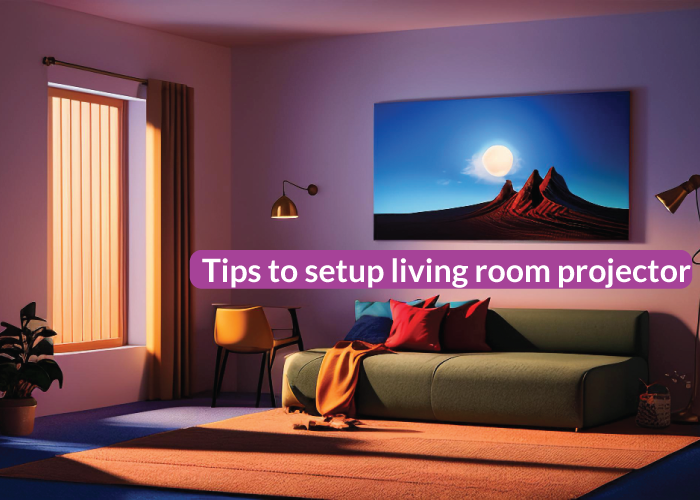An appropriate projector setup would be very beneficial for home theaters, presentations, outdoor film screenings, and other uses. It will guarantee the best possible image quality and a relaxing watching experience for your viewers. Projectors are more difficult to use than TV monitors. You have to learn how to install, concentrate, adjust the settings, and more. If you’re experiencing the same issue, we can help you set up a projector and provide professional advice from our AV specialists. Let’s talk about “Tips to setup living room projector.”
Types of projectors:
Liquid Crystal Display (LCD) projectors: These projectors generate images with this technology. They have excellent color fidelity and are reasonably priced. They might, however, have decreased refresh rates and pixilation.
DLP projectors: These projectors generate images through the use of Digital Light Processing technology. They are perfect for gaming and viewing movies since they have quick refresh rates and great contrast ratios. That being said, they have limited positioning freedom and might create the “rainbow effect”.
LED projectors: The light source in these projectors is made up of Light Emitting Diodes. When it comes to projectors, they are more energy-efficient and have a longer lifespan than others. They may not have as many brightness adjusting options as other projectors, though. Laser projectors: To produce images, these projectors employ laser diodes. They have a longer lifespan, high brightness, and outstanding color accuracy. They might, however, cost more and need to be installed by an expert. Tips to setup living room projector.
Advice For Installing Projectors Effectively:

Obtain A Good Screen:
A high-quality screen is the foundation of any good projector setup. It guarantees that the image from your projector will be clear and bright. Enhancing the brightness and vividness of the image can be achieved by amplifying the projector’s light using a high-quality projector screen.You can rent a projector and screen to achieve the greatest results for a fair price. By doing this, you may make sure that the aspect ratio, distance, and installation height of your projector match those of the screen.
Consider The Setting:
Finding the ideal place to put a projector is the first step towards using one. Larger images generally call for a closer placement of the projector relative to the screen. This implies that larger displays will require an even larger space. You also need to think about how the guests are seated. Verify that there are no objects obstructing the projector’s beam. It would be best to install the projector on the ceiling if you can’t prevent this.
Determine Your Height:
The height of your projector after installation must then be verified. This guarantees that the image is “thrown” by the projector at the proper angle. An incorrect projector height will result in a trapezoid-shaped image. It will distort the image and ruin the viewing experience for your audience. Moreover, it won’t fit the screen’s edges perfectly, which can be ugly to look at.
Select the Appropriate Aspect Ratio:
Selecting the ideal aspect ratio for your projector is essential to getting the best possible viewing experience. The relationship between the height and width of the display is known as its aspect ratio. Because most projectors have movable aspect ratios, you can align them with the dimensions of your screen.
The most popular aspect ratios and their ideal uses are listed below:
16:9 is the ideal aspect ratio for home entertainment systems.
· If you’re using the projector as a TV monitor, 4:3 compatibility is available.
· 16:10 is a nice ratio if you want to use the projector as a computer monitor.
Use An Alignment Image:
When assembling a projector and screen, seasoned AV experts utilize a “alignment image.” You may change the height and distance of the projector to fit the image edge to edge thanks to its outline. In addition, an alignment image will indicate whether the lens focus needs to be adjusted. To check if the screen is fuzzy or not quite perpendicular, you can get near to it.
Use Zoom and Focus to Obtain a Sharp Picture:
The next step is to make sure the image is clear after you’ve finished aligning it correctly. To fill your screen and stabilize the image, use the zoom and focus features of the projector. A manual knob is typically found on traditional projectors. While you’re on the go, you can change the settings using the remote controls that come with the more recent versions. It may indicate that the projector is too small for your screen size, though, if the image remains unclear despite your efforts.
Select the Appropriate Picture Mode:
The majority of projectors come with many “picture modes,” which are preset arrangements for various viewing requirements. The most popular choices include “Lamp Mode,” “Cinema Mode,” “Movie Mode,” “Vivid,” “Dynamic,” and so forth. Additionally, by using these settings, you can avoid having to manually adjust the projector setup. Nevertheless, the projector fan may become noisier and more prone to overheating in certain of these modes. This frequently occurs when the projector is in “Lamp Mode” or “Dynamic Mode,” which speeds up system operations.
Adjust The 3D Preferences:
Numerous projector models come with 2D and 3D settings that, based on the media file you’re displaying, will enhance the visual quality. While some projectors require manual adjustment, others can recognize and adapt to 3D content automatically. You can leverage the distinctive qualities of each projector to enhance the image quality. Don’t be afraid to change these for the best possible viewing experience.
Modify the contrast and brightness:
Next, remember to change your projector’s contrast and brightness. You might need to adjust the brightness and sharpness in regions with ambient illumination in order to maintain the visibility of the image. In addition, choosing a projector with the appropriate lumen count is essential. You’ll require more lumens the more strong the ambient illumination. To put this into perspective, a 1500 lumen projector will suffice for a home theater with minimal lighting. In the meanwhile, more lumens—up to 31,000 lumens—will be needed for outdoor venues to stay visible.
Listen to your audio:
Finally, after putting up the projector, don’t forget to test your audio. For brief presentations, built-in speakers included in some projectors are quite useful.
To what extent does a projector require darkness in a room?

When utilizing a projector, the surfaces of the room should be dark. The ceiling and flooring should be medium to dark, and there shouldn’t be any off-white walls. It is best if the room is darker. This still depends, though, on the type of projector you have and how big the screen is.
Conclusion:
The projector setup can be challenging. There are numerous things to think about. Nonetheless, because of its many advantages and adaptability, placing it in your living room is worthwhile. It is our experts’ wish that this post has assisted you in choosing the best living room projector setup.Now we are clear about “Tips to setup living room projector.”

